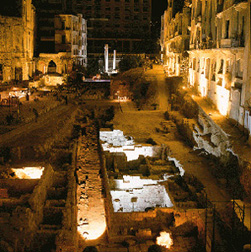|
Beirut (Bayrout)
Profile
Beirut, the capital of Lebanon.
Beirut, with its million-plus
inhabitants, conveys a sense of life and energy that is immediately apparent.
This dynamism is echoed by Capital’s
geographical position: a great promontory jutting into the blue sea with
dramatic mountains rising behind it. |
 |
Beirut
Approaching Beirut either by
sea or air promises an unforgettable sight. The mountains rising behind the city
are bathed in sunlight 300 days of the year and in winter, when they glisten
under a blanket of snow.
The destroyed town center is once again active. Its former reputation as a
crossroads between three continents and gateway to the East has been restored
and modernized. The new city planners hold computer-rendered plans that show an
extended coastline, a new residential area, and a touristic recreational zones
built around a central park.
Beirut
in History
Beirut’s
history dates back over 5,000 years. Under the city’s downtown area lie remnants
of Ottoman, Mamluke, Crusader, Abbassid, Omayyad, Byzantine, Roman, Persian,
Phoenician and Canaanite Beirut. Its name first appeared in cuneiform as early
as the 14th century B.C. In the first century B.C., it became a Roman colony,
only to be destroyed later by a triple catastrophe of earthquake, tidal wave and
fire in 551A.D. Arab control then dominated until the Crusaders took over in
1110. Following the Crusaders were the Mamlukes and the Turks. After World War I
there was a French mandate period, and in 1943 Lebanon gained its independence.
Beirut
stands on the site of a very ancient settlement going back at least 5,000 years.
Its name appeared in cuneiform inscriptions as early as the 14th century B.C. In
the first century B.C., Berytus, as it was then called, became a Roman Colony
and under Roman rule was the seat of a famous Law school which continued into
the Byzantine era.
But the
power and the glory of Berytus were destroyed by a triple catastrophe of
earthquake, tidal wave and fire in 551 A.D. In the following century Arab Muslim
forces took the city and in 1110 it fell into the Crusaders. Beirut remained in
Crusader hands until 1291 when it was conquered by the Mamlukes. Ottoman rule
began in 1516, continuing for 400 years later until the defeat of the Turks in
World War I. The French Mandate Period followed and in 1943 Lebanon gained its
independence.
Discovering
the Past
A city
continuously inhabited for millennia, until recently most of the few
archaeological discoveries in Beirut were accidental. However the war's end in
1991 provided opportunity for more comprehensive and scientific investigation.
Beneath
the ruined downtown area, which is under reconstruction, lie the remains of
Ottoman, Mamluke, Crusader, Abbassid, Omayyad, Byzantine, Roman, Persian,
Phoenician and Canaanite Beirut. With luck, a good portion of Beirut's history
will be uncovered before reconstruction is complete.
Beginning
in 1993, archaeologists and builders began cooperating on just such a project.
Teams from Lebanese and foreign institutions have found significant remains from
each of Beirut's historical periods. All discoveries are being carefully
recorded and many will be preserved.
Beirut
National Museum
 |
|
Opened in
1942 to house Lebanon’s archeological treasures, the National Museum on
Damascus Street.
Projects
were already achieved to restore the building and gradually bring this
national institution back to its former importance. Great experience could
be gained by visiting this important museum. |
A tour of the old downtown should include the Omari Mosque, the Municipality
Building, the Assaf and Amir Munzir Mosques, the Arcaded Maarad Street, the
Parliament Building, the Roman columns on Nejmeh Square and the historic Greek
Orthodox and Greek Catholic churches opposite the Parliament.
Beirut
Economy
The 1.8
million-square-meter reconstruction project for Beirut's Central District
includes hotels, office space and residential areas. But not all the buildings
will be new. Some 256 structures will be restored by 1998, plus historic mosques
and churches. Beirut's souks or markets will be reconstructed in the traditional
style by 1999.
Solidere, the private
company taking on the challenge of this 25-years project, plans a modern
infrastructure of roads utilities, public areas and marine works. More than half
a million square meters of landfill will provide land for two marinas, a seaside
promenade and a green park.
Beirut's commercial and cultural life has been mended. The city has 80 banks,
countless import-export firms, port and airport as well as a free exchange
market.
The best way to see Beirut is on foot. A good place to rest is the area of
Raouche, where Beirut's famous Pigeon Rocks stand tall and proud in the
sparkling sea. Area restaurants serve local and foreign cuisine and cliff-side
cafes offer a good range of snacks.
Sundays afford a special opportunity to those who appreciate the best in horse
racing. Beirut's race track run pure bred Arabians. Fans of this sport can
change their dollars, sterling's, etc... on the spot to place bets.
Information From the Ministry of
Tourism

|